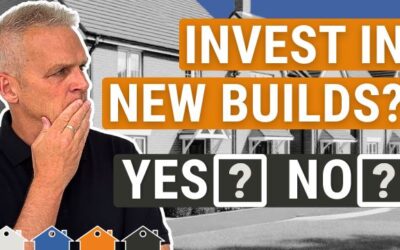9 Hidden Costs That Kill Your Property Investing Profits
Did you know there are nine hidden costs that can quietly nibble away at your property investing profits—often leaving you wondering why your latest deal isn’t actually making you any money?
Hi, I’m Tony Law. And in this post, I want to highlight these sneaky but essential costs that many newer investors simply overlook. Because here’s the truth: if you don’t factor all of these into your numbers before you commit to a deal, how can you really know whether that deal stacks up?
Stick around to the end, and I’ll also share a free downloadable resource that’ll help you assess your numbers properly moving forward.
Right, let’s get into it…
1. Stamp Duty
You probably already know this one—but do you know how it actually works?
If you’re buying a second property (whether it’s for investment or personal use), you’ll pay a 5% stamp duty surcharge on top of the normal rates.
For example:
On a £250,000 property, the standard stamp duty might be around £2,500
But add the 5% surcharge, and you’re now looking at a total of £15,000
That’s a big jump—and it catches many investors off guard, especially since the surcharge only increased from 3% to 5% recently.
📌 Top Tip: Always factor this into your upfront costs when analysing deals.
2. Legal & Compliance Costs
Yes, legal costs are expected—but many investors underestimate just how much they add up.
Typical conveyancing fees:
Around £1,500–£2,000 for a straightforward buy-to-let
But don’t forget additional compliance costs like:
EPC certificate
Gas safety certificate
EICR (Electrical Installation Condition Report)
Licensing (in some areas)
These aren’t always included in the solicitor’s quote—so you’ll need to plan ahead.
3. Surveys & Valuations
Many investors try to save money here by just going for a basic valuation or homebuyers report (roughly £400–£700).
But if you’re buying an older property or an HMO, I’d strongly recommend a RICS Level 3 survey.
It’ll cost more (about £800–£1,500) but gives you a much more detailed report—covering structural issues, damp, poor electrics, and more.
Yes, it’s a cost—but it can save you thousands and give you strong negotiating power before you buy.
4. Refurb & Maintenance Costs
This one catches out loads of new investors.
Even if a property looks “fine,” there will always be something that needs doing. And over the past few years, refurb costs have risen sharply.
Typical costs:
Rewire: £4,000–£8,000
New boiler: £1,500–£3,000
Roof repairs: anywhere from a few hundred to several thousand pounds
Garden/fencing: £500–£2,000
And if the property is empty during refurb, you’ll be footing the bill for council tax and utilities too—often over £300/month.
📌 Always get at least two quotes for any major work and build in a contingency.
5. Letting Agent Fees vs Self-Management
Using a letting agent? Expect to pay:
8–12% of monthly rent + VAT
Setup fees of £200–£400 every time they find a new tenant
Alternatively, you can self-manage, which saves money but is more hands-on:
You’ll handle advertising, viewings, referencing, rent collection, maintenance, compliance… the lot.
We do both—some of our properties are self-managed, others are with agents. It just depends on the property.
6. Voids (When the Property Is Empty)
Hardly anyone budgets for voids anymore because demand is so high—but they still happen.
And when they do, you’re not just losing rent:
You’ll be paying council tax, utilities, and general upkeep during that period.
The key to avoiding long voids?
✅ Look after your tenants
✅ Act quickly when someone gives notice
✅ Keep your property in top condition
7. Insurance (Especially for HMOs)
All landlords need buildings insurance—but for HMOs or serviced accommodation, you may also want contents insurance too.
Ballpark figures:
Standard buy-to-let: £200–£500/year
HMO: often £700+ per property
For multiple properties, consider a portfolio policy—it’s usually more cost-effective.
And make sure your insurer knows exactly what the property is being used for (HMO, SA, etc.), or your policy could be void.
8. Fire Safety Compliance (HMOs)
This is a big one—especially for HMO investors.
Depending on the property and your local council’s requirements, you may need:
Fire doors and certified latches
Interlinked smoke alarms
Fire panels and emergency lighting
Sprinklers or mist systems in some cases
These upgrades can cost thousands, and you’ll want to go beyond the bare minimum to future-proof your investment.
9. Furniture & White Goods (HMOs)
All HMO rooms need to be fully furnished. That means:
Beds, wardrobes, desks, chairs, curtains, and more
White goods like washing machines, fridge freezers, microwaves, etc.
These wear out over time—so build a contingency into your budget.
📌 Quick tip: I always take out extended warranties on white goods in HMOs (even though I never do that at home!). With 6–8 tenants using the same machine, they get worn out fast, and the warranties pay for themselves many times over.
Final Thoughts
There you have it—9 hidden costs that can seriously eat into your profits if you’re not careful.
To help you assess every deal properly, I’ve created a fully updated spreadsheet with all the obvious and hidden costs you should factor into your investment analysis—including things like mortgages, which I didn’t even mention here because I don’t consider them “hidden.”
🎁 Grab your free copy here or via the link in the description box below. It’ll help you go into every deal with your eyes wide open.
Thanks so much for reading! And if you found this helpful, I’d love it if you hit that like button and consider subscribing so you don’t miss future videos.
And if you think I’ve missed any key costs, drop me a comment—I’ll make sure to add them to the list.
Would you like this turned into a downloadable PDF or a carousel for Instagram or LinkedIn? Happy to create that too.
Ask ChatGPT
Tools
Check Out More Of Our Recent Blogs
We’d love to know if you find any of these helpful
How To Find The BEST UK Investment Property Deals
I wasn’t good at taking advice in my 20’s and 30’s… I guess because I thought I knew better. Looking back, this was a HUGE mistake.
Are New Builds A Good Investment In 2025
I wasn’t good at taking advice in my 20’s and 30’s… I guess because I thought I knew better. Looking back, this was a HUGE mistake.
Is BRRRR Dead In 2025
I wasn’t good at taking advice in my 20’s and 30’s… I guess because I thought I knew better. Looking back, this was a HUGE mistake.





0 Comments